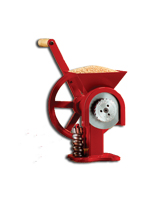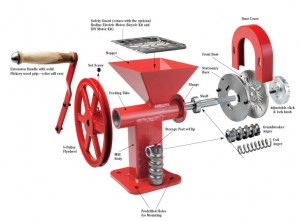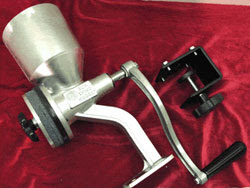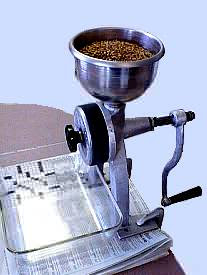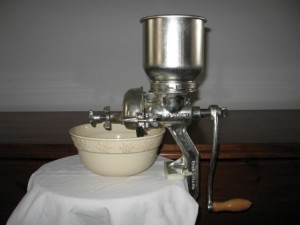 I found the Porkert Grain Mill. In retrospect, I can say it was the best value of the inexpensive mills, selling for well under $100. It was made of cast iron, had an integral screw-type augur that could feed any type of material, and had two sets of burrs, metal and ceramic, which you could change without too much trouble. The metal burrs were well-suited for grinding coarser materials, but like the first set of burrs that came with my $15 mill, they didn’t make very good flour. However, the ceramic burrs did make good flour. I worried that the ceramic burrs would break down over time, adding little bits of ceramic to my flour. I worried about damaging my teeth. And the Porkert mill was not without problems.
I found the Porkert Grain Mill. In retrospect, I can say it was the best value of the inexpensive mills, selling for well under $100. It was made of cast iron, had an integral screw-type augur that could feed any type of material, and had two sets of burrs, metal and ceramic, which you could change without too much trouble. The metal burrs were well-suited for grinding coarser materials, but like the first set of burrs that came with my $15 mill, they didn’t make very good flour. However, the ceramic burrs did make good flour. I worried that the ceramic burrs would break down over time, adding little bits of ceramic to my flour. I worried about damaging my teeth. And the Porkert mill was not without problems.
Porkert Mill Problems
It was very similar to my $15 mill, in that it was very hard to turn when set for a fine grind, and it heated the flour. Unlike the $15 mill, the Porkert could NOT be bolted down. I found its integral clamp was not strong enough to keep it from wiggling around when I ground flour. I gave the Porkert mill away to introduce a bread baking friend to the joys of grinding flour, and I was back to my problem of finding a better mill for me.
Original Review Conducted by Craig MacDonald
